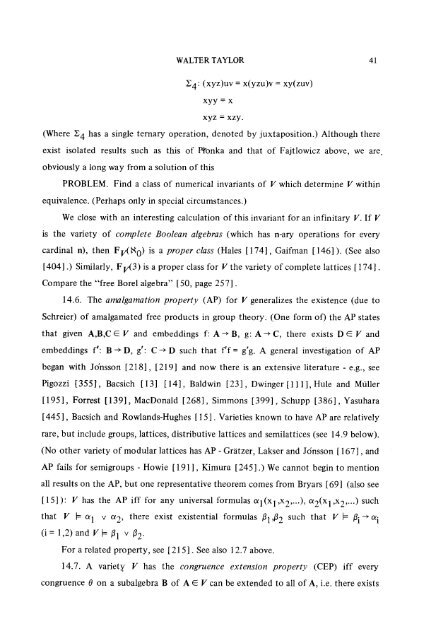Survey 1979: Equational Logic - Department of Mathematics ...
Survey 1979: Equational Logic - Department of Mathematics ...
Survey 1979: Equational Logic - Department of Mathematics ...
You also want an ePaper? Increase the reach of your titles
YUMPU automatically turns print PDFs into web optimized ePapers that Google loves.
WALTER TAYLOR 41<br />
2;4: (xyz)uv = x(yzu)v = xy(zuv)<br />
xyy = x<br />
xyz = xzy.<br />
(Where Z 4 has a single ternary operation, denoted by juxtaposition.) Although there<br />
exist isolated results such as this <strong>of</strong> P'onka and that <strong>of</strong> Fajtlowicz above, we are.<br />
obviously a long way from a solution <strong>of</strong> this<br />
PROBLEM. Find a class <strong>of</strong> numerical invariants <strong>of</strong> V which determine V within<br />
equivalence. (Perhaps only in special circumstances.)<br />
We close with an interesting calculation <strong>of</strong> this invariant for an infinitary V. If V<br />
is the variety <strong>of</strong> complete Boolean algebras (which has n-ary operations for every<br />
cardinal n), then Fl,,(tq0) is a proper class (Hales [ 174], Gaifman [ 146] ). (See also<br />
[404] .) Similarly, Fi,,(3) is a proper class for V the variety <strong>of</strong> complete lattices [174].<br />
Compare the "free Borel algebra" [50, page 257].<br />
14.6. The amalgamation property (AP) for V generalizes the existence (due to<br />
Schreier) <strong>of</strong> amalgamated free products in group theory. (One form <strong>of</strong>) the AP states<br />
that given A,B,C G V and embeddings f: A -> B, g: A -> C, there exists D V and<br />
embeddings f': B-> D, g': C-> D such that f'f= g'g. A general investigation <strong>of</strong> AP<br />
began with Jo'nsson [218], [219] and now there is an extensive literature - e.g., see<br />
Pigozzi [355], Bacsich [ 13] [ 14], Baldwin [23], Dwinger [ 111 ], Hule and Milllet<br />
[195], Forrest [139], MacDonald [268], Simmons [399], Schupp [386], Yasuhara<br />
[445], Bacsich and Rowlands-Hughes [ 15]. Varieties known to have AP are relatively<br />
rare, but include groups, lattices, distributive lattices and semilattices (see 14.9 below).<br />
(No other variety <strong>of</strong> modular lattices has AP - Gritzer, Lakser and J6nsson [ 167], and<br />
AP fails for semigroups - Howie [191], Kimura [245] .)We cannot begin to mention<br />
all results on the AP, but one representative theorem comes from Bryars [69] (also see<br />
[15]): V has the AP iff for any universal formulas Ol(Xl,X2,...), o2(Xl,X2,... ) such<br />
that V o 1 v o 2, there exist existential formulas /31,t32 such that V 13i-> oq<br />
(i = 1,2) and V 131 v 132'<br />
For a related property, see [ 215 ]. See also 12.7 above.<br />
14.7. A variety. V has the congruence extension property (CEP) iff every<br />
congruence 0 on a subalgebra B <strong>of</strong> A G V can be extended to all <strong>of</strong> A, i.e. there exists

















